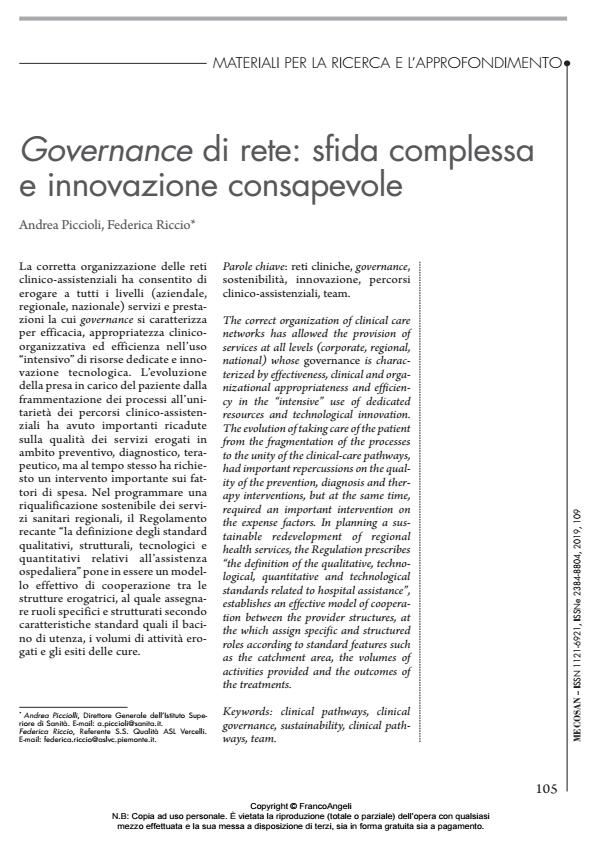Governance di rete: sfida complessa e innovazione consapevole
Journal title MECOSAN
Author/s Andrea Piccioli, Federica Riccio
Publishing Year 2020 Issue 2019/109 Language Italian
Pages 8 P. 105-112 File size 133 KB
DOI 10.3280/MESA2019-109006
DOI is like a bar code for intellectual property: to have more infomation
click here
Below, you can see the article first page
If you want to buy this article in PDF format, you can do it, following the instructions to buy download credits

FrancoAngeli is member of Publishers International Linking Association, Inc (PILA), a not-for-profit association which run the CrossRef service enabling links to and from online scholarly content.
The correct organization of clinical care networks has allowed the provision of services at all levels (corporate, regional, national) whose governance is characterized by effectiveness, clinical and organizational appropriateness and efficiency in the "intensive" use of dedicated resources and technological innovation. The evolution of taking care of the patient from the fragmentation of the processes to the unity of the clinical-care pathways, had important repercussions on the quality of the prevention, diagnosis and therapy interventions, but at the same time, required an important intervention on the expense factors. In planning a sustainable redevelopment of regional health services, the Regulation prescribes "the definition of the qualitative, technological, quantitative and technological standards related to hospital assistance", establishes an effective model of cooperation between the provider structures, at the which assign specific and structured roles according to standard features such as the catchment area, the volumes of activities provided and the outcomes of the treatments.
Keywords: Clinical pathways, clinical governance, sustainability, clinical pathways, team.
- Brown B.B., Patel C., McInnes E., Mays N., Young J., Haines M. (2016). The effectiveness of clinical networks in improving quality of care and patient outcomes: a systematic review of quantitative and qualitative studies. BMC Health Serv Res, 16: 360.
- D.M. n. 70 del 2 aprile 2015, “Regolamento recante definizione degli standard qualitativi, strutturali, tecnologici e quantitativi relativi all’assistenza ospedaliera”. Gazzetta Ufficiale della Repubblica Italiana. [online] -- Disponibile a: <http://www.regioni.it/news/2015/06/05/d-m-7002-04-2015-regolamento-recante-definizione-degli-standardqualitativi-strutturali-tecnologici-e-quantitativirelativi-allassistenza-ospedaliera-407117/> [Ultimo accesso 13 novembre 2018].
- Donabedian A. (1980). The definition of quality and approaches to its assessment. Exploration in quality assessment and monitoring. Ann Arbor: Health Administration Press.
- Grimshaw J.M., Thomas R.E., MacLennan G., Fraser C., Ramsay C.R., Vale L., Whitty P., Eccles M.P., Matowe L., Shirran L., Wensing M., Dijkstra R., Donaldson C. (2004). Effectiveness and efficiency of guideline dissemination and implementation strategies. Health Technology Assessment, 8(6): 1-72. DOI: 10.1017/S0266462305290190
- Monitor 42. FOCUS ON Programma Nazionale Esiti (2018). Agenzia Nazionale per i Servizi Sanitari Regionali. [online] -- Disponibile a: <http://www.agenas.it/images/agenas/monitor/pdf/monitor_42_per_sito.pdf> [Ultimo accesso 13 novembre 2018].
- Monitor 43. FOCUS ON Le Reti tempo-dipendenti. (2018). Agenzia Nazionale per i Servizi Sanitari Regionali. [online] -- Disponibile a: <http://www.agenas.it/images/agenas/monitor/pdf/monitor_43.pdf > [Ultimo accesso 13 novembre 2018].
- Muir Gray J.A. (1997). Evidence-based healthcare: how to make health policy and management decisions.
- London: Churchill Livingstone Porter M.E. (2010). What is value in Health Care? The New England Journal of Medicine, 363: 2477-2481.
- Rotter T., Kinsman L., James E., Machotta A., Gothe H., Willis J., Snow P., Kugler J. (2010). Clinical pathways: effects on professional practice, patient outcomes, length of stay and hospital costs. Cochrane Database Syst Rev, 3: CD006632.
- Taylor C., Munro A.J., Glynne-Jones R., Griffith C., Trevatt P., Richards M., Ramirez A.J. (2010). Multidisciplinary team working in cancer: What is the evidence? BMJ Clinical Research, 340(7749): 743-745. DOI: 10.2307/40701899
- Walshe K. (2009). Pseudoinnovation: the development and spread of healthcare quality improvement methodologies. International Journal of Quality in Health Care, 21(3): 153-9.
- Whitty C. (2015). What makes an academic paper useful for health policy? BMC Medicine, 13:301.
Andrea Piccioli, Federica Riccio, Governance di rete: sfida complessa e innovazione consapevole in "MECOSAN" 109/2019, pp 105-112, DOI: 10.3280/MESA2019-109006